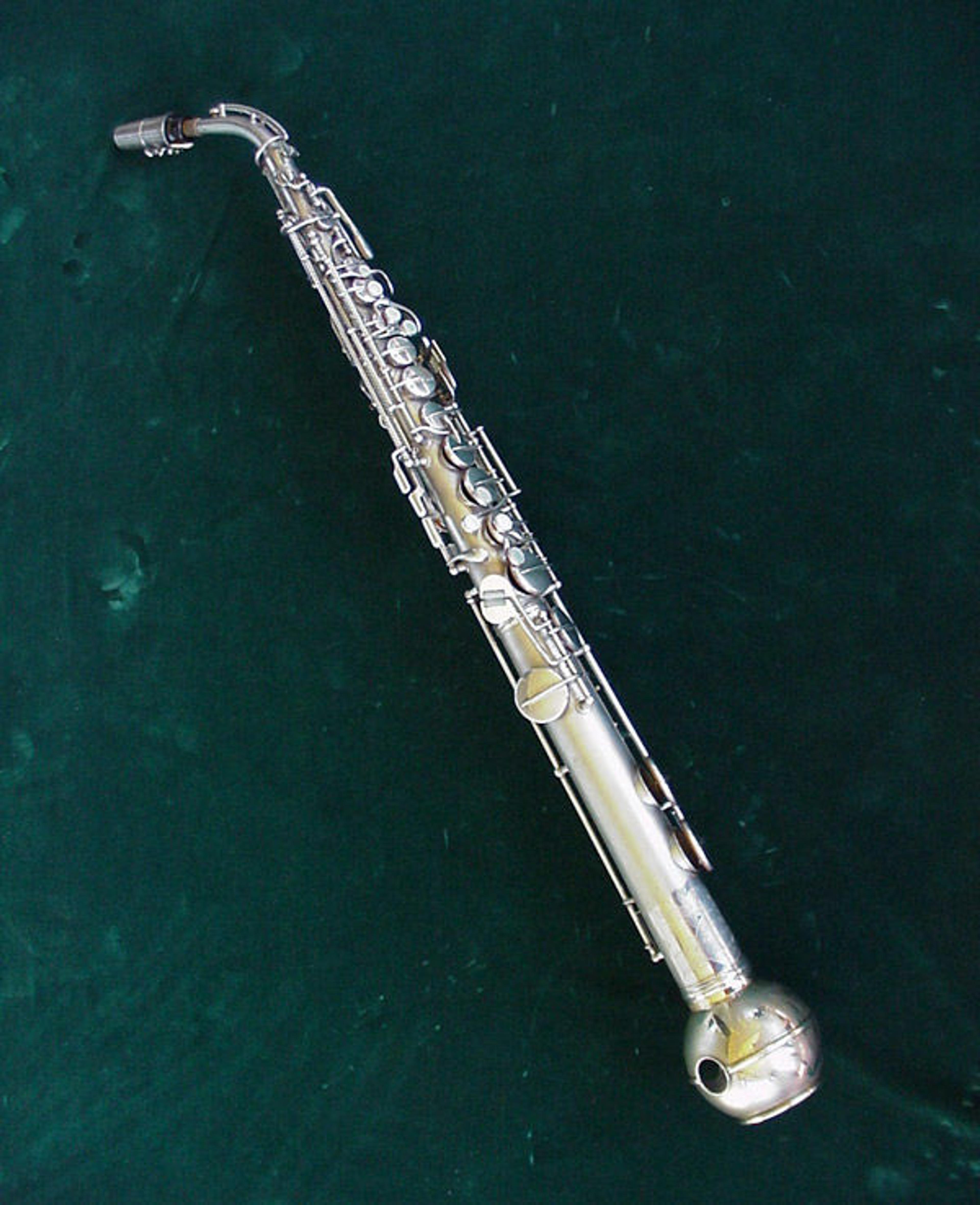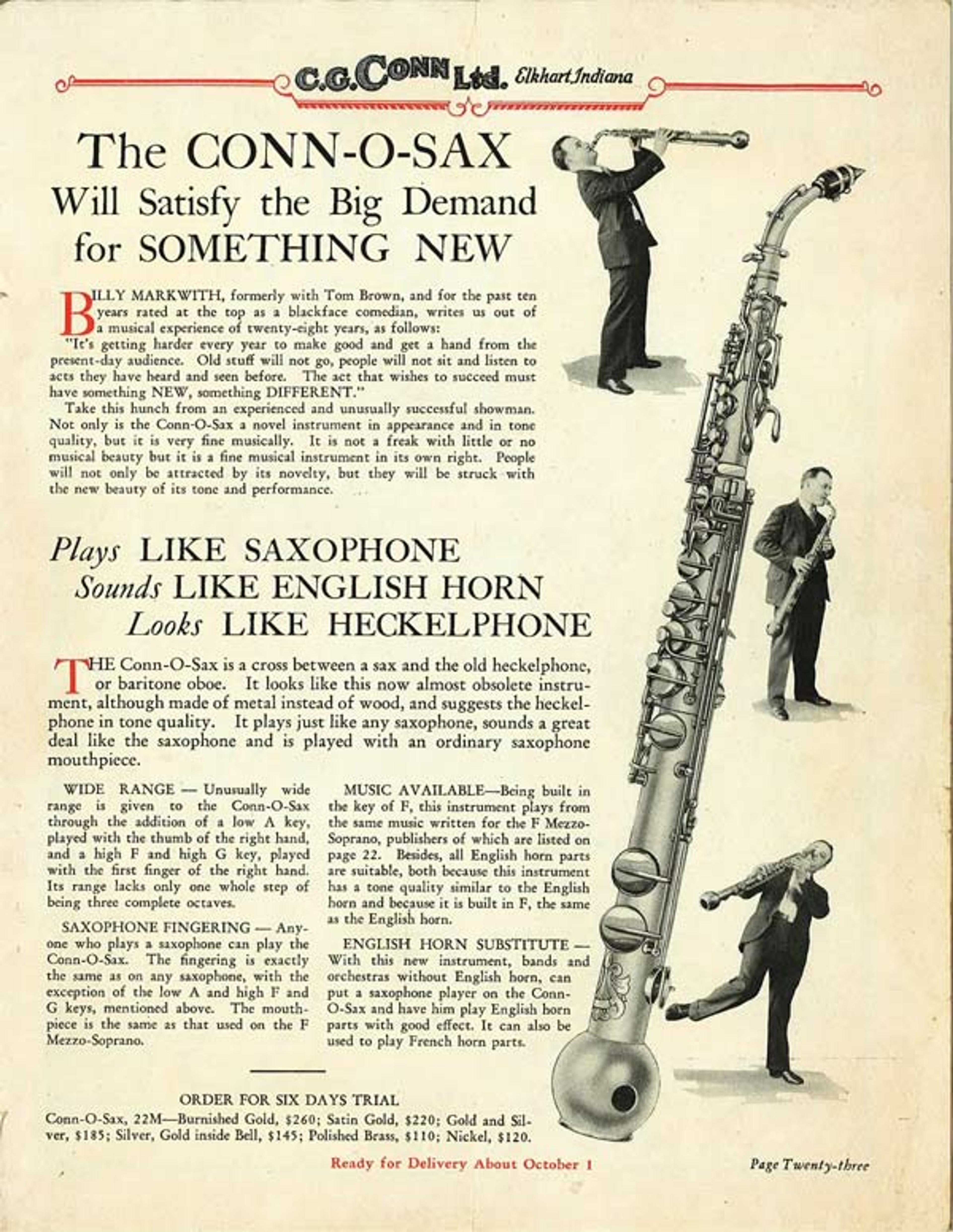
The Conn-O-Sax. All images courtesy of the author
From Bradley Strauchen-Scherer, Associate Curator in the Department of Musical Instruments:
Now featured in the exhibition Celebrating Sax: Instruments and Innovation, on view through February 21, 2016, is a rare Conn-O-Sax—one of the most sonically and visually intriguing members of the saxophone family. It has been generously loaned to the Museum for the exhibition by leading saxophone performer, teacher, and historian Paul Cohen. In this post, Paul shares insights into the Conn-O-Sax and other rare alto voices of the saxophone family.
«The Conn-O-Sax was a bold, innovative F alto saxophone made by American instrument manufacturer Conn for a very limited time in 1928. Combining elements of the saxophone and two double-reed instruments, the English horn and heckelphone, Conn attempted to create a new voice for the saxophone. Its innovations were numerous: a straight instrument with a pronounced bulb-shaped bell reminiscent of the English horn, pitched in the key of F (E-flat and B-flat are the typical keys for saxophones), and equipped with an extended range and a custom mouthpiece. The result was a unique timbre, visual appearance, and technical versatility that was visionary for its time. The Conn-O-Sax succeeded brilliantly as a new instrument in America but ultimately failed in the marketplace; we know of only twenty-five to still exist.»
Saxophone Innovation in America
No discussion of the American F alto can rightfully begin without at least a brief look into the decade that spawned its creation. From approximately 1915 to 1925, there existed a saxophone craze that brought unprecedented popularity to the instrument. Over one million saxophones were sold in this period, which is amazing considering the population and economic conditions of the time. Saxophones featured in all facets of music making. They were an integral part of the school and community bands as well as the famous military and touring bands. Vaudeville groups such as the Six Brown Brothers Saxophone Sextet captured the ears and eyes of their audiences with consorts of saxophones in all sizes. The saxophone became indispensable to theater orchestras, where there was so much work available that players could get on-the-job training in the pit. In the middle of the decade, Variety estimated that there were as many as sixty thousand dance bands or combos working in the United States, all of which used one or more saxophones.
The prosperity of the manufacturers and the relatively cheap labor at the time allowed larger companies such as Buescher, Conn, and King to maintain full-time research and development divisions for advancing and improving the design and manufacture of instruments. Given an enlightened management, these departments were also given free rein to experiment. Conn made at least several one-handed saxophones in response to wounded veterans returning from World War I, in addition to developing the Strobe-0-Conn tuner. King made a curved sopranino (an example of which is on display in Celebrating Sax: Instruments and Innovation) while Buescher built a straight alto in addition to experimenting and producing padless alto and tenor saxophones for the American Selmer company.
Novelty and individuality were key ingredients of society in the Roaring Twenties, a fact that did not escape the attention of the instrument makers. The prospect of increased sales prompted many of them to develop and produce new or unusual variations of saxophones to capture the fancy of the public. Both Conn and Buescher included E-flat sopraninos in their catalogues, which served a dual function: it preserved the integrity of the companies as being "complete" saxophone manufacturers, as well as maintaining a novelty item for consideration.
Lyon & Healy sold a bizarre soprano saxophone in the shape of what can best be described as a miniature alto clarinet. King came out with their very popular saxello, which somewhat resembles a foghorn—thankfully in shape only! King also experimented with an alto in the shape of a saxello. The conventionally curved soprano, of which many today are especially fond, became popular as a novelty item. It persevered no doubt because the acoustical characteristics were found to be artistically desirable, though somewhat temperamental.
The American F Alto Saxophone
Beginning around 1926, a change began overtaking the country. The overt faddism of the saxophone was drawing to a close. Although still popular, it would never again sell in such astounding numbers as in previous years. Newer forms of entertainment began competing with established mediums, which began to produce fundamental changes in the fabric of American society. The movie industry began enjoying tremendous growth, competing directly with vaudeville, dance halls, and clubs. With the introduction of talkies, the need for live music while the picture played was eliminated. Radio enjoyed a similar growth as the emphasis began to change from the performing artist to the studio musician. An undercurrent of severe economic uncertainty was also beginning to reveal itself. A mild recession developed in the late 1920s that culminated, to a disbelieving and unprepared America, in the stock market crash of 1929 and the subsequent Great Depression.
Because of dramatically dwindling sales, the two largest saxophone manufacturers, Conn and Buescher, decided on a course of action designed to bolster the instrument's popularity. Buescher came out with their straight alto and tipped-bell soprano in January of 1927. This involved only minor retooling, as they were still produced in E-flat and B-flat. Conn, the larger and more ambitious of the two, designed two completely new instruments altogether—the F mezzo-soprano, and the Conn-O-Sax.
The F mezzo-soprano was introduced with great fanfare in the spring 1928 issue of Conn's magazine, Musical Truth. The major obstacle to the acceptance of this instrument was, of course, the total absence of music written for it. This problem was quickly reconciled by Conn, who persuaded major music publishers to include F mezzo-soprano parts in their saxophone arrangements. In addition to the F mezzo-soprano, Conn introduced the Conn-O-Sax later in the year, which was advertised with a heavy emphasis on its novelty, presumably to woo the diminishing vaudeville clientele. Expecting to sell many F mezzo-sopranos, Conn expanded production operations, which was a tremendously expensive proposition. Their hope was to attract a separate and popular clientele for the Conn-O-Sax. Unfortunately, the instrument did not sell well, and the anticipated sales never materialized. Despite heavy advertising and dealer promotion, the Conn-O-Sax simply did not catch on.

Advertisement for the Conn-O-Sax in Musical Truth, published by C.G. Conn, 1928
Conn had badly miscalculated in a number of ways. The novelty aspect of the horn never gained widespread appeal; vaudeville was dying, and people were getting out, not getting in. The days of the Roaring Twenties were drawing to a close. As the economic recession deepened, people were less concerned with new and exotic instruments and more concerned with basic necessities. In addition, there simply was little music of value for the F horns, despite advertisements to the contrary. While Conn continued to list the F mezzo-soprano in catalogues through the 1930s, there is no mention of the Conn-O-Sax after 1930.
Today there is a renewed interest in these long-forgotten saxophones whose haunting, brooding sounds are especially effective in a concert setting. It took the raised consciousness of succeeding generations to rediscover and apply the artistic possibilities of the entire family of saxophones. Although the saxophone craze of the 1920s is no longer with us, we can be thankful that the productive imagination of those times created such an array of varied instruments.
Paul Cohen performs Guy de Lioncourt's Three Gregorian Chants for saxophone and organ with organist Harry Huff at Northwestern University
Related Links
Celebrating Sax: Instruments and Innovation, on view November 6, 2014–February 21, 2016
Met Blogs: View all blog posts related to this exhibition.